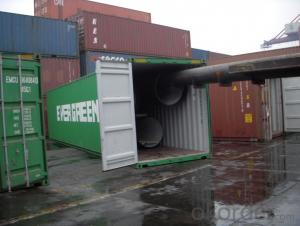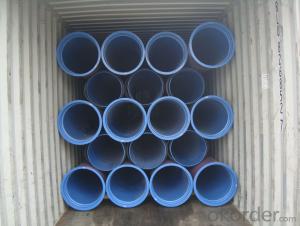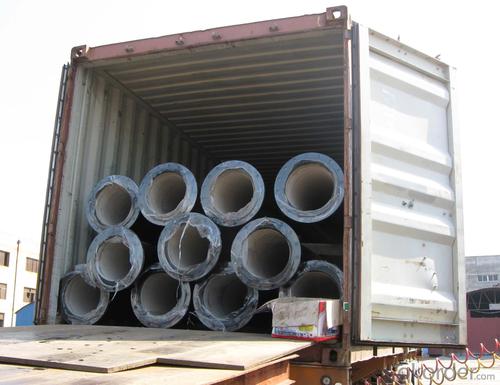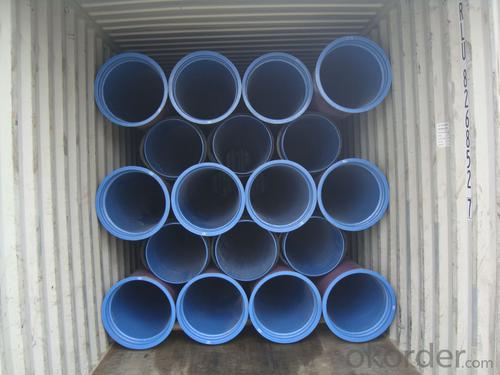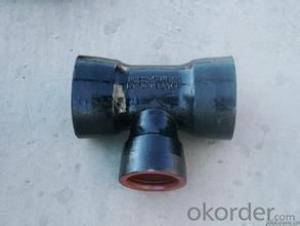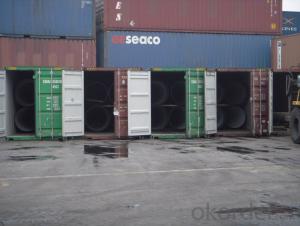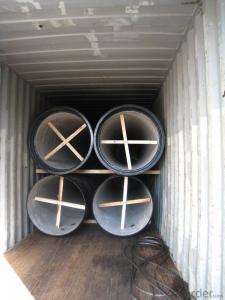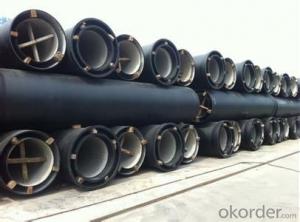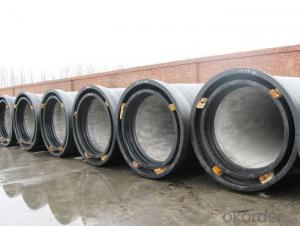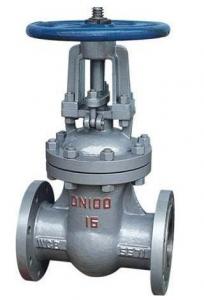DUCTILE IRON PIPES C Class DN700
- Loading Port:
- China Main Port
- Payment Terms:
- TT OR LC
- Min Order Qty:
- -
- Supply Capability:
- -
OKorder Service Pledge
OKorder Financial Service
You Might Also Like
Ductile Iron Cast Pipe is without any defects compare with tradition casting tech, which has many advantages particularly as follow:
(1) High density. In the "vertical upward casting" process, the melt iron of centre liquid column in center crystallizer is continuously feeding for volume shrinkage caused by condensation tube at outer circumference , which lead to be free of shrinkage porosity.
(2) High purity. When melt iron pouring, the mixed impurities such as gas, dross, sand grain which are lighter than melt iron could be eliminated at furnace mouth, its impossible to enter into the crystallizer through the channel, so the melt iron into the crystallizer is very pure.
(3) Strength with toughness. The cooling speed provided by continuous crystallizer is 30 times than sand casting and 5 times than centrifugal casting, and doesn't produce white iron, the eutectic cell volume of continuous cast iron is one eighth to one tenth compare with traditional cast iron. The density of graphite nodule in ductile iron can reach 300-700 pcs/mm2. Therefore, all reason above improve the strength and toughness of continuous cast iron.
(4) Free machining. The high speed cooling make the hardening phase (such as boride, steadite) not appear like reticular, massive or thick, but diffuse like fish bone and pane in shape, moreover, there are tiny graphite flakes inlaid hardening phase. It's free machining in BrinellHardness the range of 250-300HB. However, the Brinell Hardness of 250 is top limit to common metal materials.
(5) Uniform composition of tube wall. The convection mixing of liquid column caused by marching type drawing in crystallizer make the composition of tube wall well-distributed, and concentration gradient very little.
(6) High productivity. To the wall thickness of tube under 10mm, the speed of continuous casting is 1 meter/min, to the wall thickness of tube under 20mm, the speed of continuous casting is 0.5 meter/min, which is high efficiency that centrifugal or other casting tech couldn't reach.
- Q: Can ductile iron pipes be used for underground fuel storage systems?
- No, ductile iron pipes are not suitable for underground fuel storage systems. They are more commonly used for water and sewer applications due to their strength and durability in carrying liquids. Underground fuel storage systems require materials that are specifically designed to handle the corrosive nature of fuel and prevent leaks or contamination, such as double-walled fiberglass or steel tanks.
- Q: Can ductile iron pipe be used for wastewater treatment plants?
- Yes, ductile iron pipe can be used for wastewater treatment plants. Its durability, corrosion resistance, and high strength make it a suitable choice for handling the harsh and corrosive environment of wastewater treatment processes. Additionally, ductile iron pipes can withstand high operating pressures and provide long-term reliability, making them an ideal option for transporting wastewater within the treatment plant.
- Q: Can ductile iron pipes be used for irrigation systems?
- Yes, ductile iron pipes can be used for irrigation systems. Ductile iron pipes have excellent strength and durability, making them suitable for a variety of applications, including irrigation. These pipes are resistant to corrosion and have a long lifespan, ensuring that they can withstand the harsh conditions often associated with irrigation systems. Additionally, ductile iron pipes have a smooth interior surface, which allows for efficient water flow and reduced friction loss. This makes them ideal for transporting water over long distances, ensuring proper irrigation of crops or landscapes. Overall, ductile iron pipes are a reliable and cost-effective choice for irrigation systems.
- Q: Can ductile iron pipes be used in areas with high levels of industrial effluents?
- Yes, ductile iron pipes can be used in areas with high levels of industrial effluents. Ductile iron is a type of cast iron that has enhanced flexibility and strength, making it highly resistant to corrosion and abrasion. This makes it suitable for handling various types of industrial effluents, including those with high levels of chemicals, acids, or other corrosive substances. Ductile iron pipes have a protective lining, such as cement mortar or polyethylene, which further enhances their resistance to chemical attack. These linings prevent the effluents from coming into direct contact with the iron material, ensuring the longevity and integrity of the pipes. Moreover, ductile iron pipes have been used extensively in industrial applications where corrosive environments are present. They have proven to be durable and reliable, with a long service life, even in challenging conditions. Proper maintenance and regular inspections are essential to ensure the continued performance of ductile iron pipes in areas with high levels of industrial effluents. It is crucial to consider the specific characteristics of the effluents and consult with experts or manufacturers to determine the most suitable pipe materials and linings for the particular industrial environment.
- Q: How do ductile iron pipes handle water hammer?
- Ductile iron pipes are known for their excellent resistance to water hammer, which refers to the sudden increase in pressure and velocity of water flow within a pipe system. This phenomenon occurs when there is a sudden change in the water's velocity, such as when a valve is closed abruptly or a pump is suddenly shut off. Ductile iron pipes are designed to withstand high-pressure surges caused by water hammer. Their enhanced strength and flexibility enable them to absorb and dissipate the energy generated during these pressure surges. The ductility of the material allows the pipe to deform slightly under the impact of the water hammer, preventing the pipe from rupturing or breaking. Moreover, ductile iron pipes have inherent damping properties, which means they can absorb and dissipate the energy of water hammer more effectively compared to other pipe materials. This helps to reduce the intensity and duration of the pressure surges, minimizing the potential damage to the pipe system and its components. Additionally, ductile iron pipes are often equipped with various fittings and accessories that further enhance their ability to handle water hammer. These include specialized joint designs, such as restrained joints or flexible couplings, which provide additional flexibility and resistance to pressure surges. Overall, ductile iron pipes are specifically engineered to handle the challenges posed by water hammer. Their strength, flexibility, damping properties, and specialized fittings make them an ideal choice for applications where water hammer is a concern, providing a reliable and durable solution for water distribution systems.
- Q: How to analyze and judge the quality of ductile iron pipe
- The most intuitive judgment ductile pipe quality is the ratio of the thickness of cement and iron, cement thick wall thicker tube quality is better, there are also some manufacturers of the pipe, thick wall pipe head cast iron part looks to be thick, but there is also a thin iron pipe, so the judge quality to open look inside, personally think that the highest price of the manufacturer is Jinan steel, Jinan Iron and steel because the pipe quality can reach the national standard K9, the price is also lower than the emerging, Saint Gobain and other major brands, as the water supply pipe K8 is no problem, but the price and quality aspects for the construction of which more importance.
- Q: How does ductile iron pipe compare to PVC pipe in terms of strength?
- Generally, ductile iron pipe is considered stronger than PVC pipe due to its composition of iron and carbon, which provides it with high tensile strength and resistance to breakage. It is commonly utilized in heavy-duty applications like water mains, sewer lines, and industrial piping due to its ability to withstand high pressures. On the flip side, PVC pipe is manufactured using a plastic material known as polyvinyl chloride. While PVC pipe is lightweight and easy to handle, it lacks the strength of ductile iron pipe. It is typically used in low-pressure applications such as household plumbing, irrigation systems, and drainage pipes. When comparing the strength of ductile iron pipe to PVC pipe, the former has a greater capacity to handle heavy loads, endure ground movement, and resist damage from external factors like rocks or tree roots. Additionally, ductile iron pipe is more durable and has a longer lifespan in comparison to PVC pipe. However, it is important to consider that the choice between ductile iron pipe and PVC pipe ultimately depends on the specific requirements of the project. Factors such as cost, environmental conditions, ease of installation, and desired longevity should all be taken into account when determining the appropriate type of pipe to utilize.
- Q: What does "K8" mean in ductile iron pipe grades?
- In wall thickness, K is the standard for wall thickness. The smaller the figure, the thinner the wall thickness of the same specification.For example, the K7 wall thickness of K8 is less than K8, and the wall thickness of DN500 is less than K9
- Q: How are ductile iron pipes protected against stray electrical currents?
- Ductile iron pipes, which are commonly used for water and sewer systems, are protected against stray electrical currents through a process known as cathodic protection. This method involves applying a low-voltage direct current (DC) to the pipes, which creates a protective electrical field around them. Cathodic protection is achieved by installing sacrificial anodes or impressed current systems near the ductile iron pipes. Sacrificial anodes, typically made of a more electrically active metal such as zinc or magnesium, are connected to the pipes and serve as the source of electrical current. These anodes corrode over time, sacrificing themselves to protect the pipes from corrosion due to stray electrical currents. Impressed current systems, on the other hand, utilize an external power source to supply the protective electrical current. Rectifiers are used to convert alternating current (AC) to direct current (DC) and the DC is then applied to the pipes through anodes. This method allows for more control over the amount of current being applied, ensuring optimal protection. In both cases, the electrical current flowing through the sacrificial anodes or impressed current systems creates a protective barrier around the ductile iron pipes. This barrier prevents the stray electrical currents from flowing through the pipes, reducing the risk of corrosion and extending the lifespan of the infrastructure. Regular monitoring and maintenance of the cathodic protection system are essential to ensure its effectiveness. This involves inspecting the anodes, checking the electrical current levels, and making any necessary adjustments or replacements to maintain the desired level of protection. Overall, cathodic protection is a reliable and widely used method to protect ductile iron pipes against stray electrical currents, safeguarding the integrity and longevity of water and sewer systems.
- Q: Can ductile iron pipes be used in tunneling or microtunneling projects?
- Yes, ductile iron pipes can be used in tunneling or microtunneling projects. Ductile iron pipes are known for their durability, strength, and resistance to corrosion, making them suitable for underground applications. They can handle the pressure and load requirements of tunneling projects and provide reliable and long-lasting performance.
Send your message to us
DUCTILE IRON PIPES C Class DN700
- Loading Port:
- China Main Port
- Payment Terms:
- TT OR LC
- Min Order Qty:
- -
- Supply Capability:
- -
OKorder Service Pledge
OKorder Financial Service
Similar products
Hot products
Hot Searches
Related keywords
